Key takeaways:
- Music journalism combines storytelling with personal connection, emphasizing the importance of capturing the emotions behind music.
- Maintaining work-life balance is vital for creativity and productivity, with self-care and hobbies enhancing journalistic work.
- Effective time management techniques, such as the Pomodoro Technique and setting boundaries with social media, foster a productive work environment.
- Building a supportive network and embracing feedback from peers is essential for growth and authenticity in music journalism.

Understanding music journalism
Music journalism is an intricate tapestry that weaves together the stories of artists, genres, and cultural movements. I remember the first time I interviewed a local band; the excitement and nervousness mixed into a cocktail of emotions made me realize how vital storytelling is in this field. Every article is not just about the notes and lyrics but about capturing the essence of a moment.
In my experience, music journalism often requires a balance between objectivity and personal perspective. It’s tempting to let your biases color your writing, but I’ve learned that transparency is crucial. When I wrote a review of an album that really struck a chord with me, I made sure to explain why it resonated with my personal journey—sharing that connection added depth to my piece.
Have you ever felt deeply moved by a song that seemed to express everything you were going through? Every listener has that powerful connection, and as a music journalist, it’s my job to explore and articulate those emotions for readers. I strive to create a bridge between the artist’s intent and the audience’s experience, fostering a greater understanding of the music we love.
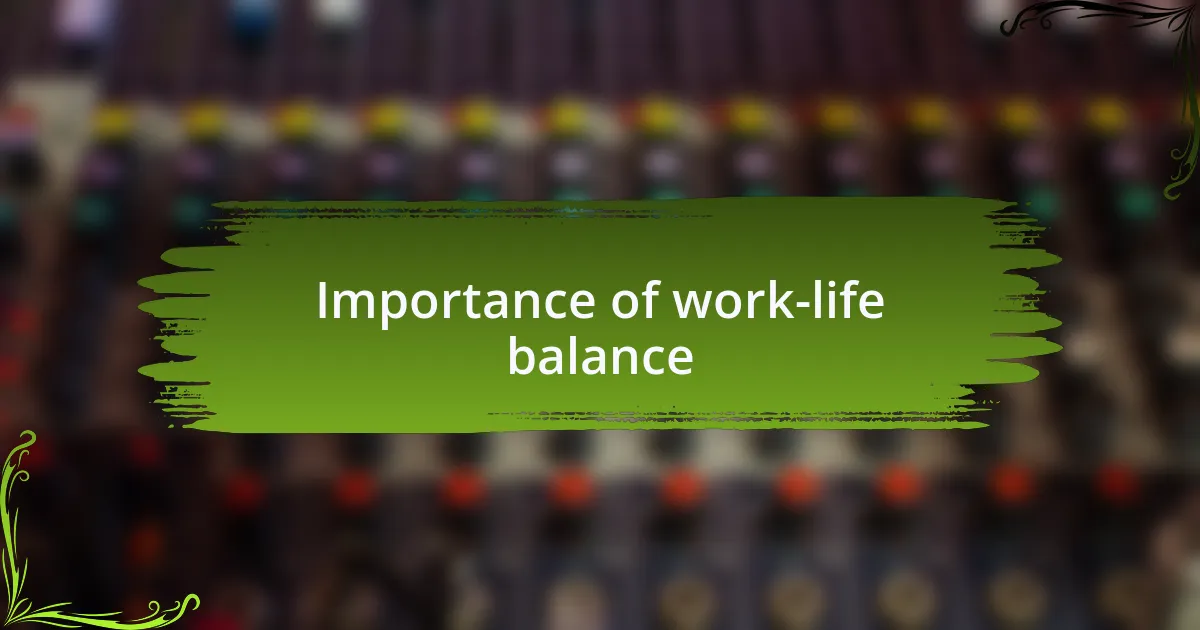
Importance of work-life balance
Maintaining a healthy work-life balance is crucial in music journalism, where the lines between professional and personal life often blur. I remember a particularly hectic period where late nights and deadlines took over my life. It became clear to me that I had to step back and prioritize self-care; without that balance, my creativity and passion for writing suffered.
Work-life balance fosters not only mental well-being but also enhances productivity. When I started carving out time for hobbies outside of writing—like playing guitar or simply enjoying live music—I found that my work became more vibrant and inspired. This shift reminded me why I fell in love with music in the first place, rekindling the fire I needed to excel in my journalism.
Have you ever faced burnout after pouring everything into your work? I have, and it taught me that taking breaks is not just beneficial; it’s essential. By nurturing a life outside of my journalism, I discovered a reservoir of fresh perspectives that enriched my writing, proving that fulfillment can come from both personal and professional realms.
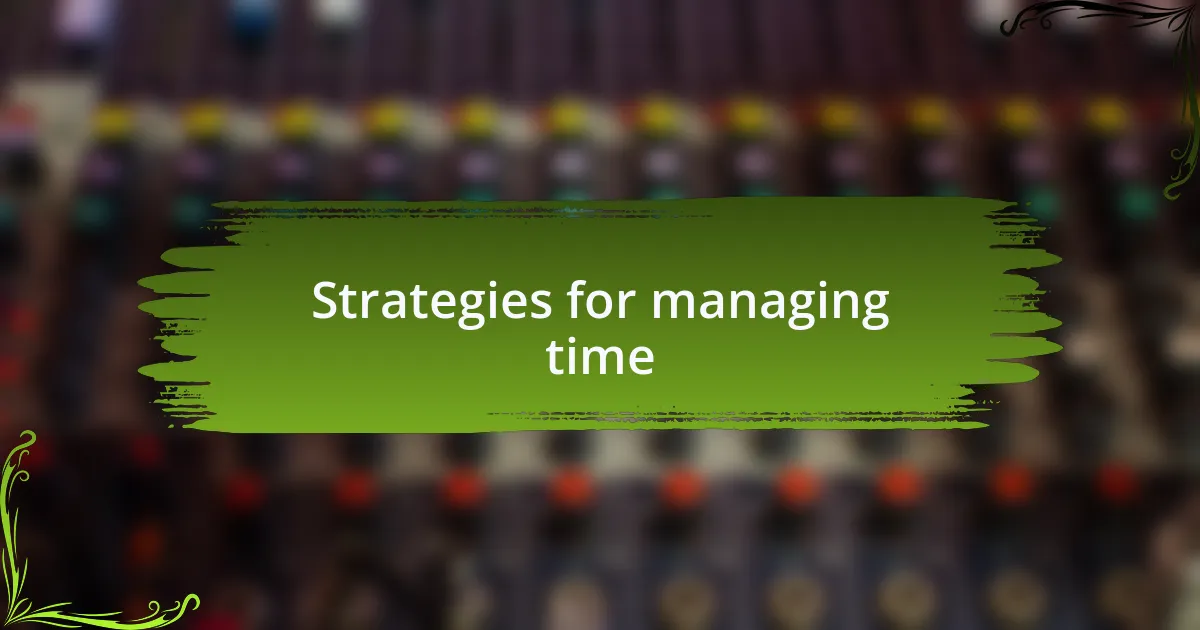
Strategies for managing time
Time management can sometimes feel like an elusive goal, especially when passion projects blur the boundaries of leisure and work. One strategy that has worked wonders for me is setting clear priorities. I often start my week by mapping out deadlines and allocating specific time slots for writing, research, and even self-care. By treating my own creative time with respect, I create a structure that allows space for inspiration to strike, rather than scrambling to squeeze it in.
Another effective approach I’ve integrated into my routine is the Pomodoro Technique, a method that includes focused work sessions followed by short breaks. I vividly recall a late-night writing session when I adopted this technique on a whim. Instead of feeling mind-numbed and fatigued after hours of writing, I found that breaking my time into 25-minute segments not only kept my energy up but also sparked bursts of creativity that I had previously thought were lost. Isn’t it fascinating how a simple tweak to our work pace can unlock new levels of productivity?
Lastly, don’t underestimate the power of setting boundaries, particularly with social media. I made it a habit to limit my screen time during work hours, and it was liberating. By creating an environment free of digital distractions, I learned to immerse myself fully in the writing process, allowing the music I love to shine through without interruption. Have you tried unplugging from the noise? The clarity I gained from this practice transformed not just my workflow, but my overall perspective on what it means to balance art and life harmoniously.
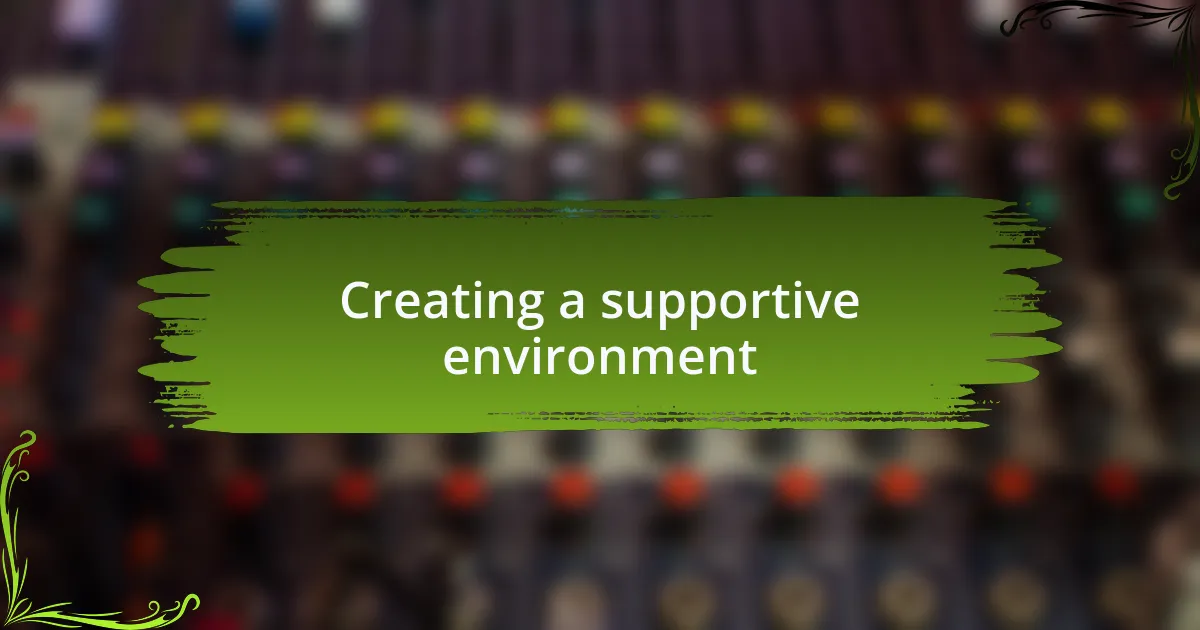
Creating a supportive environment
Creating a supportive environment is essential for nurturing creativity. I remember the moment I decided to transform my workspace into a sanctuary. I added plants, framed photos, and even my favorite vinyl records. This personal touch not only lifted my spirits but also created a space that felt safe for exploration. Have you considered how your surroundings impact your creativity?
Another crucial aspect of building a supportive environment is surrounding yourself with like-minded individuals. In my early days of music journalism, I joined a local writing group, and it was a game-changer. Sharing ideas and receiving feedback from fellow creatives not only provided accountability but also filled me with inspiration. I often left those meetings buzzing with new energy, motivated to dive back into my projects.
Finally, creating an atmosphere of encouragement extends beyond physical spaces. I’ve found it vital to communicate openly with family and friends about my artistic commitments. When they’re aware of my goals and time needs, they can support me better, whether it’s by respecting my writing hours or celebrating my milestones, big or small. How do you communicate your creative aspirations to those around you?
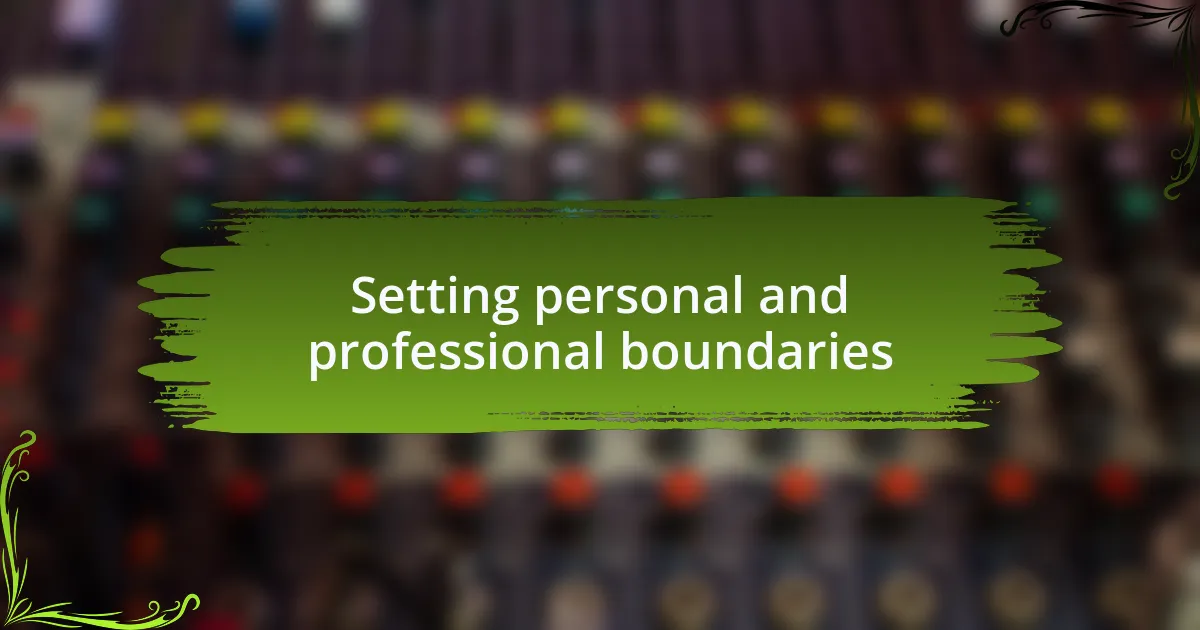
Setting personal and professional boundaries
Setting clear personal and professional boundaries was a pivotal step in my journey. I recall when I first started, I often felt overwhelmed, trying to say yes to every invitation and opportunity. It wasn’t until a mentor advised me to delineate my work hours from personal time that I truly began to regain control over my life. Have you ever felt like you were stretched too thin, trying to balance your commitments?
I began to implement strict rules for myself; I designated evenings as my creative time, removing distractions like social media and phone notifications. This allowed me to immerse myself in my work without outside pressure. It’s amazing how much clarity I found by establishing these boundaries. How much more productive could you be if you carved out uninterrupted time for your passion?
Setting boundaries also applies to my interactions with others in the industry. I learned to be selective with my collaborations, choosing only those that aligned with my artistic vision and personal values. This intentionality not only made my projects more fulfilling but also infused my work with authenticity. Have you evaluated your collaborations to ensure they truly resonate with your core beliefs?
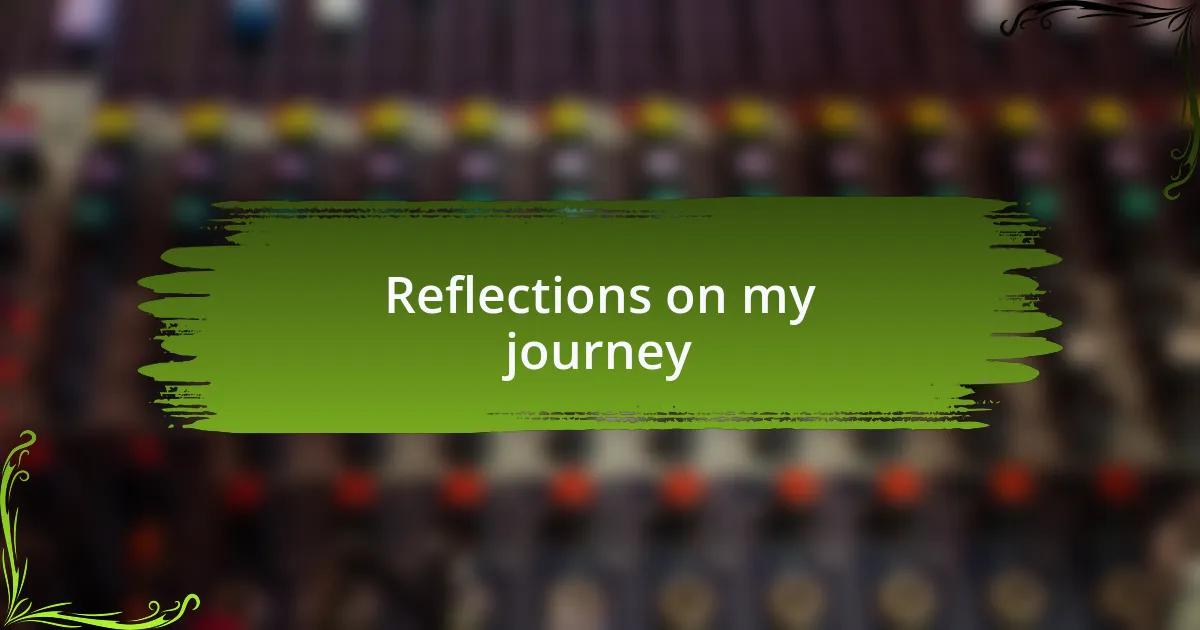
Reflections on my journey
Reflecting on my journey, I often find myself marveling at how far I’ve come in balancing art and life. There was a time when I equated my worth solely with my output, churning out articles even if it drained my spirit. I vividly remember one particular week when I felt more like a robot than a writer, and it hit me hard—was this really the passion I fell in love with?
In those moments of exhaustion, I learned the vital importance of rest and rejuvenation. I think back to a weekend when I finally unplugged from deadlines and allowed myself to wander through a local art exhibit. That experience inspired my work and reminded me that creativity thrives in moments of genuine observation and enjoyment. Isn’t it fascinating how stepping away can spark the best ideas?
As I reflect further, I recognize that my journey also encompasses the connections I’ve forged along the way. I’ve met artists and journalists who share the same struggles, and through late-night conversations, we’ve exchanged stories of triumph and vulnerability. What sustains me is knowing I’m part of a community that understands the delicate dance of passion and pragmatism. Don’t we all benefit from sharing our stories and learning from one another?
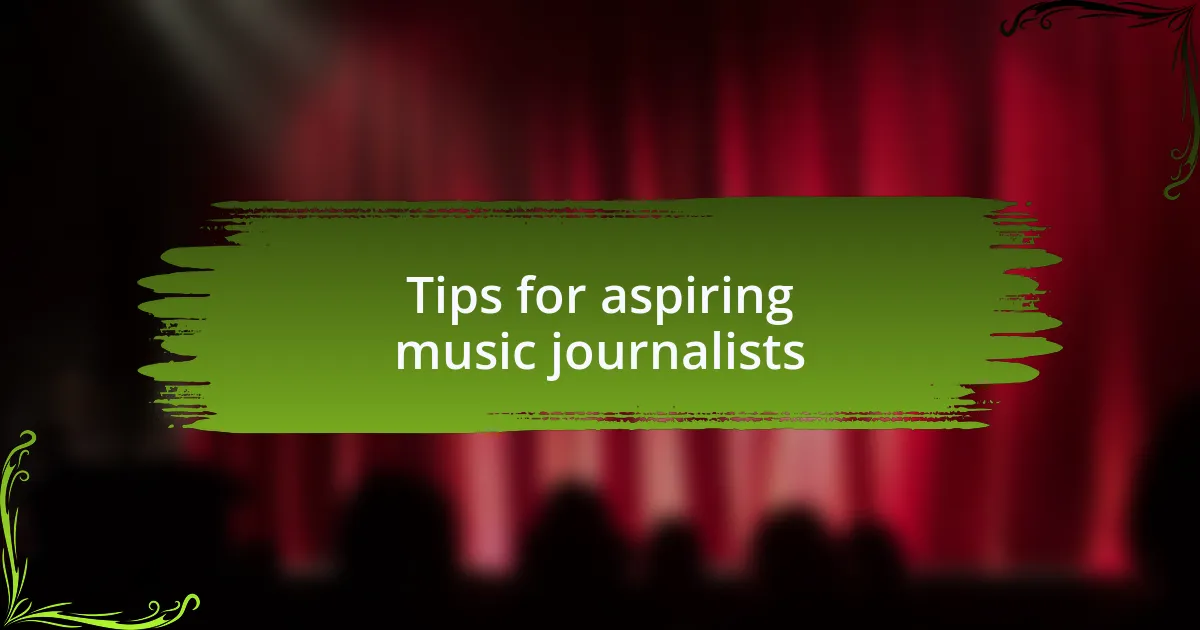
Tips for aspiring music journalists
The journey to becoming a successful music journalist isn’t just about writing; it’s about staying curious. I remember the time I attended a small local gig, not exactly knowing what to expect. To my surprise, the raw energy and authenticity of the performers gave me a fresh perspective. Engaging with artists in person often opens doors to stories that don’t come through emails or press releases. So, why not dive deep into experiences rather than hovering around the surface?
Building relationships is equally crucial in this industry. I’ve found that genuine connections can truly transform your career. One unforgettable conversation with a well-established journalist over coffee not only inspired me but also led to my first major assignment. These moments remind me that sometimes, opportunities arise from casual interactions. How often do we overlook the power of simply being present and connecting with others?
Lastly, don’t underestimate the power of feedback. I once submitted an article that I thought was my best work, only to receive constructive criticism from my editor that reshaped my approach. While it stung at first, that feedback became a catalyst for my growth as a writer. Consider it a challenge rather than a setback. Embracing critiques can be your ticket to honing your craft and finding your unique voice in the myriad of voices in music journalism.